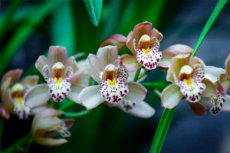Orchid growth
Last reviewed: 29.06.2025

Orchids are not only beautiful but also demanding plants that require proper care for successful growth and flowering. In this article, we will discuss how orchid roots, leaves, and flower spikes grow, as well as provide tips for stimulating their growth at home.
Orchid root growth
Orchid root growth is one of the most important processes on which the plant's health and flowering depend. Healthy roots provide the orchid with the necessary nutrients and moisture, so it is essential to monitor their condition.
- Watering for root growth. Watering is a key factor in orchid root growth. Orchids require regular but moderate watering to prevent root rot. Water only when the substrate is completely dry.
- Root growth stimulators. To accelerate orchid root growth, you can use a root growth stimulator for orchids, such as succinic acid. This helps the plant better absorb nutrients and stimulates the development of new roots.
Growth point in orchids
The growth point of an orchid is the area from which new leaves and flower spikes develop. Where is the growth point located in an orchid? It is usually found in the center of the leaf rosette and serves as the main growth point of the plant.
- Growth point damage. If the growth point of the orchid has rotted, it can lead to a halt in growth and even the death of the plant. In this case, it is important to carefully remove the damaged tissue and treat it with a fungicide to prevent further infection.
- Orchid without a growth point. If an orchid lacks a growth point, recovery can be difficult but possible. In this situation, it is important to stimulate lateral buds so that they start developing.
Flower spike growth in orchids
Flower spike growth in orchids is a joyous event for any grower, as beautiful flowers appear on the spike. Sometimes the flower spike may grow from the growth point, which complicates further leaf development.
- What to do if the flower spike grows from the growth point? In this case, it is important to provide the orchid with all the necessary conditions for flowering, as further leaf growth may be hindered. Monitor lighting, watering, and fertilizing the plant.
- Stimulating flower spike growth. To stimulate flower spike growth in orchids, you can use special fertilizers for orchid flower spike growth that contain phosphorus and potassium.
Leaf growth in orchids
Leaf growth in orchids is also important for the overall health of the plant. Leaves participate in photosynthesis and provide the plant with energy for growth and flowering.
- Conditions for leaf growth. For successful leaf growth in orchids, proper lighting and humidity are necessary. Orchids prefer bright but diffused light and high air humidity.
- Leaf growth stimulators. To stimulate leaf and root growth in orchids, you can use a growth activator for orchids that contains vitamins and microelements necessary for growth.
Stimulating orchid growth
To stimulate orchid growth at home, you can use various methods and means, such as growth stimulators, fertilizers, and proper care.
- Growth stimulators for orchids. There are special growth stimulators for orchids that help accelerate the growth of roots, leaves, and flower spikes. For example, succinic acid or a paste for awakening dormant buds.
- Fertilizers for orchids. Using fertilizers for root and flower spike growth in orchids helps the plant receive all the necessary nutrients. It is important to choose fertilizers with a high phosphorus and potassium content to stimulate flowering.
- Conditions for orchid growth. Creating optimal conditions is the key to successful orchid growth and development. Provide the plant with enough light, humidity, and the correct temperature regime.
What to do if orchid growth stops?
Sometimes, orchid growth may stop. This can be due to a lack of light, improper watering, or nutrient deficiency.
- Why has orchid growth stopped? Growth can stop due to stress, overwatering, or insufficient lighting. It is important to identify the cause and adjust the plant's care.
- How to stimulate orchid growth? Use growth stimulators, provide the plant with good lighting and moderate watering. It is also recommended to apply fertilizers containing essential microelements.
Growth of orchid keikis
Sometimes keikis (young plants) can appear on an orchid, developing on the flower spike or at the base of the parent plant.
- Orchid keiki growth can be stimulated with special pastes or fertilizers. Once the keiki forms several roots, it can be carefully separated and planted in a separate pot.
- Stimulants for keiki growth. Using root growth stimulators helps keikis root faster and start independent development.
Conclusion
Orchid growth is a complex process that requires attention and proper care. Knowing the features of root, leaf, and flower spike growth in orchids will help you create optimal conditions for the successful development of your plant. Use growth stimulators, provide proper watering, lighting, and humidity, and your orchid will delight you with its healthy appearance and beautiful flowering.
Remember that conditions for orchid growth play a key role. Timely fertilization, proper care, and attention to the plant's condition will help you grow a beautiful and healthy orchid that will bloom and bring joy for many years.
